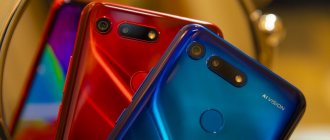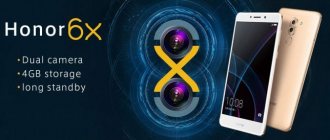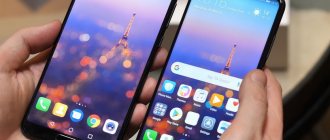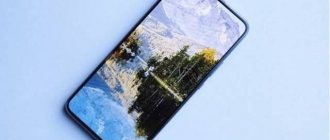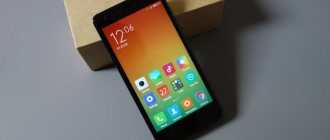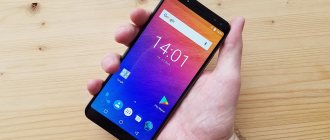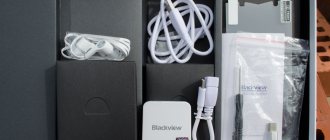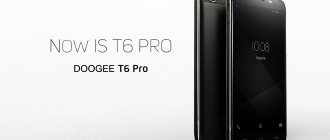The main question that involuntarily arises in your head when you get acquainted with the technical characteristics of the new Huawei Honor 7: why was it necessary to release it if there is an almost identical one? Seriously, analyze the two right columns of the table below - you will see that the Honor 7 and Huawei P8 are very, very similar. The fact is that in its homeland, China, Honor is already a separate brand, aimed at young people, and distributed exclusively via the Internet, due to which it is possible to reduce the final cost of the devices.
The line of devices, which was previously called Huawei Ascend P, and now simply Huawei P, was the top one in the company’s range and remains so. This means that the P8 is a gadget made with a focus on design and image. It stands on the polished display windows of trading floors, and there, in these same trading floors, they ask for money as for a full-fledged flagship smartphone. Let's put it simply: Honor 7 was originally made cheaper than P8. In Russia, the current price for the “seven” is 23 thousand rubles, and for the premium P8 – 30 thousand. Let's try to figure out what Huawei engineers saved on when creating Honor 7...
⇡#Technical characteristics
| Huawei Honor 6 | Huawei Honor 6 Plus | Huawei Honor 7 | Huawei P8 | |
| Touch screen | 5 inches, 1920 × 1080 pixels, IPS; 445 dpi; capacitive, up to ten simultaneous touches | 5.5 inches, 1920 × 1080 pixels, IPS; 401 dpi; capacitive, up to ten simultaneous touches | 5.2 inches, 1920 × 1080 pixels, IPS; 423.6 dpi; capacitive, up to ten simultaneous touches | 5.2 inches, 1920 × 1080 pixels, IPS; 423.6 dpi; capacitive, up to ten simultaneous touches |
| Air gap | No | No | No | No |
| Oleophobic coating | Eat | Eat | Eat | Eat |
| Polarizing filter | Eat | Eat | Eat | Eat |
| Factory film | No | No | No | No |
| System-on-a-chip | HiSilicon Kirin 920 (ARM big.LITTLE architecture): four ARM Cortex-A15 cores, 1.7 GHz + four ARM Cortex-A7 cores, 1.3 GHz (ARMv7), 28 nm process technology; 32-bit computing | HiSilicon Kirin 925 (ARM big.LITTLE HMP architecture): four ARM Cortex-A15 cores, 1.8 GHz + four ARM Cortex-A7 cores, 1.3 GHz (ARMv7) + Smart i3 coprocessor, 28 nm HPm process technology; 32-bit computing | HiSilicon Kirin 935 (ARM big.LITTLE HMP architecture): four ARM Cortex-A53 cores, 1.5 GHz frequency + four ARM Cortex-A53e cores, 2.2 GHz frequency (ARMv8) 28 nm HPm process technology; 32-bit and 64-bit computing | HiSilicon Kirin 930 (ARM big.LITTLE HMP architecture): four ARM Cortex-A53 cores, 1.5 GHz frequency + four ARM Cortex-A53e cores, 2 GHz frequency (ARMv8) 28 nm HPm process technology; 32-bit and 64-bit computing |
| Graphics controller | ARM Mali-T628 MP4, frequency 600 MHz | ARM Mali-T628 MP4, frequency 600 MHz | ARM Mali-T628 MP4, frequency 600 MHz | ARM Mali-T628 MP4, frequency 600 MHz |
| RAM | 3 GB LPDDR3-1600 | 3 GB LPDDR3-1600 | 3 GB LPDDR3-1600 | 3 GB LPDDR3-1600 |
| Flash memory | 16 GB (11.5 GB available to user) + microSD | 16/32 GB (we tested a 32 GB version - 25.1 GB available to the user) + microSD | 16/32/64 GB (we tested a 16 GB version - 10.7 GB available to the user) + microSD | 16/32 GB (we tested a 16 GB version - 11.3 GB available to the user) + microSD |
| Connectors | 1 × Micro-USB 2.0 1 × 3.5 mm headset jack 1 × MicroSD 1 × Micro-SIM | 1 × Micro-USB 2.0 1 × 3.5 mm headset jack 1 × Micro-SIM 1 × Nano-SIM/microSD (combined) | 1 × Micro-USB 2.0 1 × 3.5 mm headset jack 1 × Nano-SIM 1 × Nano-SIM/microSD (combined) | 1 × Micro-USB 2.0 1 × 3.5 mm headset jack 1 × Nano-SIM 1 × Nano-SIM/microSD (combined) |
| cellular | 2G/3G/4G One SIM card in Micro-SIM format | 2G/3G/4G* One SIM card in Micro-SIM format + one SIM card in Nano-SIM format, which can be replaced with a microSD memory card | 2G/3G/4G One Nano-SIM format SIM card + one Nano-SIM format SIM card, instead of which you can install a microSD memory card | 2G/3G/4G One Nano-SIM format SIM card + one Nano-SIM format SIM card, instead of which you can install a microSD memory card |
| Cellular connection 2G | GSM/GPRS/EDGE 850/900/1800/1900 MHz | GSM/GPRS/EDGE 900/1800/1900 MHz | GSM/GPRS/EDGE 850/900/1800/1900 MHz | GSM/GPRS/EDGE 850/900/1800/1900 MHz |
| Cellular 3G | DC-HSPA+ (42.2/5.76 Mbps) 900/2100 MHz | HSDPA (42.2/5.76 Mbps) 850/900/1900/2100 MHz TD-SCDMA 1900/2000 MHz | HSDPA (42.2/5.76 Mbps) 900/1900/2100 MHz TD-SCDMA 1900/2000 MHz | HSDPA (42.2/5.76 Mbps) 900/1900/2100 MHz TD-SCDMA 1900/2000 MHz |
| Cellular 4G | LTE Cat. 6 (300/50 Mbps) FDD: Band 1, 3, 7, 20 (2100/1800/900/800 MHz), TDD: Band 38 (2600 MHz) | LTE Cat. 6 (300/50 Mbps) Band 1, 3, 7, 38, 39, 40, 41 (2100/1800/2600/1900/2300/2500 MHz) | LTE Cat. 6 (300/50 Mbps) Band 1, 3, 7, 8, 20 (2100/1800/2600/900/800 MHz) | LTE Cat. 6 (300/50 Mbps) Band 1, 2, 3, 4, 5, 7, 8, 12, 17, 18, 19, 20, 25, 26, 28, 40 (2100/900/1800/1700/ 850/2600/900/700/800/2300 MHz) |
| WiFi | 802.11a/b/g/n, 2.4 and 5 GHz + Wi-Fi Direct | 802.11a/b/g/n, 2.4 and 5 GHz + Wi-Fi Direct | 802.11a/b/g/n, 2.4 and 5 GHz + Wi-Fi Direct | 802.11a/b/g/n, 2.4 and 5 GHz + Wi-Fi Direct |
| Bluetooth | 4.0 + A2DP | 4.0 + A2DP | 4.1 | 4.1 |
| NFC | No | Yes - only for the version with LTE | No | No |
| IR port | Yes | Yes | Yes | No |
| Navigation | GPS, A-GPS, GLONASS | GPS, A-GPS, GLONASS | GPS, A-GPS, GLONASS | GPS, A-GPS, GLONASS |
| Sensors | Light sensor, proximity sensor, accelerometer/gyroscope, magnetometer (digital compass) | Light sensor, proximity sensor, accelerometer/gyroscope, magnetometer (digital compass) | Light sensor, proximity sensor, accelerometer/gyroscope, magnetometer (digital compass) | Light sensor, proximity sensor, accelerometer/gyroscope, magnetometer (digital compass) |
| Fingerprint's scanner | No | No | Yes | No |
| Main camera | 13 MP (4160 × 3120), Sony Exmor RS CMOS sensor with back-illumination, Autofocus, single LED flash | Dual, 8 MP sensors (3264 × 2448), Software image stitching up to 13 MP, Autofocus, dual LED flash | 20 MP (5152 × 3888), Sony Exmor RS CMOS sensor with back-illumination, Autofocus, dual LED flash | 13 MP (4160 × 3120), Sony Exmor RS CMOS sensor with back-illumination, Autofocus, single LED flash |
| Front-camera | 5.1 MP (2592 × 1952), no autofocus | 8 MP (3264 × 2448), no autofocus | 8 MP (3264 × 2448), no autofocus | 8 MP (3264 × 2448), no autofocus |
| Nutrition | Non-removable battery: 11.78 Wh (3100 mAh, 3.8 V) | Non-removable battery: 13.68 Wh (3600 mAh, 3.8 V) | Non-removable battery: 11.78 Wh (3100 mAh, 3.8 V) | Non-removable battery: 10.18 Wh (2680 mAh, 3.8 V) |
| Size | 140 × 70 mm Case thickness: 7.5 mm | 150.5 × 75.7 mm Case thickness 7.5 mm | 143 × 72 mm Case thickness 8.5 mm | 145 × 72 mm Case thickness 6.4 mm |
| Weight | 130 g | 165 g | 157 g | 144 g |
| Housing protection | No | No | No | No |
| operating system | Android 4.4.2 Own shell EmotionUI 2.3 | Google Android 4.4.2 (KitKat) Own shell EmotionUI 3.0 | Google Android 5.0.2 (Lollipop) Own shell EmotionUI 4.0 | Google Android 5.0.2 (Lollipop) Own shell EmotionUI 3.1 |
| Current price | 19,990 rubles | 22,990 rubles for the 16 GB version 25,990 rubles for the 32 GB version | 22,990 rubles | 26,990 rubles |
* There is a version of Huawei Honor 6 Plus without LTE support, but it is not officially supplied to Russia. It has strictly 16 GB of built-in flash memory, while the version with LTE support can be equipped with 16 or 32 GB of memory. Accordingly, when purchasing a version with 16 GB of flash memory, just in case, it is worth checking whether this copy has LTE support.
| Honor 7 – information about the system and hardware according to the CPU-Z application | ||||
Detailed technical specifications
Make and model
Make and model of the device, and alternative names (if any).
| Brand Device manufacturer company. | Huawei |
| Model Device name. | Y7 Pro 2019 |
| Alternative names Other model names, if available. Sometimes the model is called differently, depending on the country or because of popular nicknames. | Y7 Pro (2019) DUB-LX2 |
Design
Appearance of the device including dimensions, weight, volume, colors and materials.
| Width The horizontal side of the device when used in standard orientation. | 76.91 mm (millimeters) |
| Height The vertical side of the device when used in standard orientation. | 158.92 mm (millimeters) |
| Thickness The cross-sectional size of the device. | 8.1 mm (millimeters) |
| Weight How much does the device weigh excluding the case, SIM and memory cards and other additional elements. | 168 g (grams) |
| Volume Approximate value calculated using the formula: length times width times height. | 99 cm³ (cubic centimeters) |
| Colors What colors is the device available in? | Blue Black Red |
| Housing materials What materials is the body made of? | Polycarbonate |
System on a Chip (SoC)
A system on a chip, a single-chip system (System on a Chip, SoC) is when several systems performing different device functions are connected on one chip.
| System on a Chip (SoC) A single-chip system that contains components such as a processor, graphics accelerator, memory units, communication interfaces, etc., as well as software for the operation of the system. | Qualcomm Snapdragon 450 |
Central processing unit (CPU)
| Central processing unit (CPU) The main component of the device is responsible for calculations and data processing. | ARM Cortex-A53 |
| Technical process What technological process is used to make the chip? The smaller the process technology, the better - the chips consume less power and generate less heat. | 14 nm (nanometers) |
| Processor size Processor capacity is a parameter that indicates how many bits of data a processor register processes in 1 clock cycle. This is usually 32 or 64 bits. | 64 bit |
| Instruction Set Architecture Instruction set architecture (ISA) is a programmable part of the microprocessor core used by software to control the operation of the processor. | ARMv8 |
| Number of processor cores The processor can be either single-core or multi-core. The performance of the processor depends on the number of cores (threads). The more cores working simultaneously, the higher the power consumption, so in mobile devices all cores are used only under high load. | 8 |
| CPU clock speed Clock speed is the number of operations per second that a processor or its core can achieve. The higher the frequency, the higher the overall performance of the device, but performance also depends on the processor architecture and the number of cores. | 1800 MHz (megahertz) |
Graphics Processing Unit (GPU)
| Graphics Processing Unit (GPU) The graphics processing unit (GPU) is used to process and display graphics - 3D effects, games, interfaces and other visual elements. Due to the pipeline architecture, the GPU is many times more efficient in graphics processing than the processor. | Qualcomm Adreno 506 |
Random access memory (RAM)
| Amount of random access memory (RAM) RAM (Random Access Memory, RAM, RAM) is temporary memory (works only while the device is running), which stores data and code for the operational operation of programs and applications. The more RAM, the more programs you can run simultaneously without loss of performance (there will be fewer “brakes”). | 3 GB (gigabytes) |
| Type of random access memory (RAM) Information about the type of RAM used by the device. | LPDDR3 |
| Number of RAM channels 1 is a single-channel RAM operating mode, basic, when 1 memory module is used. 2 is already a two-channel mode - a mode of parallel operation of 2 modules or pairs of modules, memory channels - this mode is 2 times faster than a single-channel one. 3 – three-channel mode is 3 times faster than single-channel mode. | Single channel |
| RAM frequency The frequency of RAM determines the speed of RAM, or rather the speed of data transfer and reception. In theory, the higher the frequency, the more powerful the RAM. | 933 MHz (megahertz) |
Built-in memory
Most mobile devices have built-in Flash memory, which is used as a storage for system data, the operating system, as well as user data - photos, videos, recordings and much more.
| Built-in memory capacity The higher the amount of built-in memory, the more games, programs, music, videos and your other files will fit in the device, especially the amount of memory is important when the device does not support memory cards. | 32 GB (gigabytes) |
Operating system
A mobile operating system (OS) is pre-installed software with a well-thought-out interface for user control of device functions.
| Operating system (OS) The operating system installed by default by the device manufacturer, as well as its version. | Android 8.1 Oreo |
| User interface User interface (UI - user interface) is usually a graphical shell that ensures the transfer of information between the user and the operating system. | EMUI 8.2 |
Battery
To operate autonomously, a mobile device requires a battery that powers all its components.
| Battery capacity The main characteristic of a battery is its maximum capacity, that is, the charge it can store. Capacity is measured in mAh (mAh, milliamp-hour). The higher the capacity, the longer the mobile device can work. | 4000 mAh (milliamp-hours) |
| Battery type Many types of batteries have been used in portable devices, but NiCd (nickel-cadmium), NiMH (nickel-metal hydride), and even more so SLA (lead-acid) batteries are already considered obsolete. Instead, modern mobile devices use Li-Ion (lithium-ion) and Li-Pol, Li-Poly (lithium-polymer) batteries. | Li-polymer |
| Power adapter Characteristics of the charger (adapter, power supply) included in the standard package of the mobile device. More precisely, the output voltage in volts (V) and the output current in amperes (A). | 5 V (volts) / 2 A (amps) |
Screen
The screen (display) is the main element for displaying graphic information.
| Technology The technology used to make the screen. There are many types of display manufacturing with their pros and cons. | IPS |
| Diagonal The screen diagonal of a device is measured in inches (inch, in or simply ″), and 1″ is equal to 2.54 cm. | 6.26 in (inches) 159 mm (millimeters) 15.9 cm (centimeters) |
| Width Approximate screen width | 68.07 mm (millimeters) 6.81 cm (centimeters) |
| Height Approximate screen height | 143.7 mm (millimeters) 14.37 cm (centimeters) |
| Aspect Ratio Aspect ratio is the ratio of the shorter side of the screen, which is considered to be 1, to the longer side, which is denoted by a decimal fraction indicating the ratio to the short side. | 2.111:1 |
| Screen resolution Screen resolution is the number of horizontal pixels (dots) multiplied by the number of vertical pixels. The higher the resolution, the more detailed the image will be. | 720 x 1520 pixels |
| Pixel Density The number of pixels per inch or PPI (pixels per inch) indicates the density of pixels per 1 inch (2.54 cm) of the screen. The higher the PPI, the sharper the image, and the less visible or even invisible “squares and dots” (pixels). | 269 ppi (pixels per inch) 105 ppcm (pixels per centimeter) |
| Color depth Color depth means how many bits are used in 1 pixel to display color (bits per pixel). | 24 bit 16777216 colors |
| Screen area Approximate usable area occupied by the screen on the front of the device. The higher the percentage, the narrower the frames around the display or the smaller the “chin with bangs.” | 80.28% (percent) |
| Touch screen A touch screen is a device that usually covers the display and is a touch input tool. In fact, in mobile devices, the touchscreen is a replacement for the keyboard and mouse. | Yes |
| Touch screen type There are many types of touch screens, with their pros and cons. Mobile devices often use capacitive touchscreens, but technology does not stand still and new types of sensors are appearing. | Capacitive |
| Multi-touch Touch screen support for two or more touches. For example, zooming photos with two fingers. | Yes |
| 2.5D screen 2.5D is a display with rounded edges. Device manufacturers use a 2.5D screen as a design element, for a pleasant tactile sensation, or to add durability, dust and moisture protection. | Yes |
Main camera
The main camera, usually built into the rear of the device, is designed for creating photo and video content.
| Maximum image resolution This is the maximum number of pixels (dots) horizontally and vertically. The higher the resolution, the more detailed the image will be. Resolution can also be indicated in megapixels - this is the total number of pixels that can be in the image, calculated by the formula: vertical pixels multiplied by the number of horizontal pixels and divide the resulting amount by 1 million. | 4160 x 3120 pixels 12.98 MP (megapixels) |
| Matrix type There are two main types of photomatrix, CCD (Charge-Coupled Device) and CMOS (Complimentary Metal-Oxide Semiconductor). Mobile devices mainly use a CMOS matrix - it requires less space, has low power consumption and heating. Recently, new types of sensors have begun to appear, for example PureCel from OmniVision. | CMOS BSI (backside illumination) |
| Diaphragm Aperture (f-number, f) is used to control the light flux passing through the lens. The aperture is indicated by a fraction, and the smaller the fractional number, the higher the aperture passing through the lens. The more light that passes through the lens, the better overall, less noise in your photos and better night photography. | f/1.8 |
| Flash type Most mobile devices are equipped with light-emitting diode (LED) flashes, but there are also xenon flashes. As a flash, xenon is better - it is more powerful, but LED is more versatile (can work as a flashlight) and consumes less electricity. | LED |
| Maximum video resolution This is the maximum number of pixels (dots) horizontally and vertically. The higher the resolution, the more detailed the image will be. | 1920 x 1080 pixels 2.07 MP (megapixels) |
| FPS video recording at maximum resolution FPS (Frames per Second, frame rate) is the number of frames that changes in 1 second. The higher the number of frames per second, the smoother the image will be. In this case, we mean the number of frames that the camera can achieve at its maximum resolution; the lower the resolution, the higher the FPS can be. | 30 fps (frames per second) |
| Presence of flash Incorporating a flash into a mobile device allows you to take pictures in low light conditions. Creates the necessary lighting and compensates for the lack of natural light. | Yes |
| Digital zoom With digital zoom (zoom, enlargement), the subject is brought closer due to software image algorithms. The higher the magnification with digital zoom, the worse the image quality (noise, blur) will be compared to a non-zoomed one. | Yes |
| Focus on face Function of auto-detection of living objects and autofocus on their face or head. | Yes |
| Panoramic shooting mode Panoramic photography is a series of frames where each subsequent frame is a continuation of the previous one; at the end of the shooting, all frames are stitched together at the software level to create a panoramic photograph. Frames can be shot both vertically and horizontally, and their width can be up to 360 degrees. This type of shooting is used when the camera's viewing angle is not enough to capture the entire scene. | Yes |
| HDR shooting mode HDR photography takes a quick series of shots with highlights, midtones, and shadows, then combines them into a single frame with high dynamic range. | Yes |
| Electronic (digital) image stabilizer EIS (Electronic Image Stabilizer - digital image stabilization) is performed using software algorithms and is needed to reduce blurring when the camera shakes. | Yes |
| White balance White balance is a setting that helps ensure the correct color reproduction in an image by determining the color temperature of the light source in the frame. The balance can be set either automatically or manually. | Yes |
| ISO Setting ISO is the level of light sensitivity. The lower the ISO, the less sensitive the camera's light sensor and the smoother the image with less noise. The higher the ISO, the higher the light sensitivity, but more noise, graininess, or decreased sharpness. | Yes |
| Additional Information Additional information about the functions and characteristics of cameras. | Autofocus Continuous shooting Geo-tagging Touch focus Exposure compensation Self-timer Scene select mode |
Additional cameras
Secondary cameras allow you to expand the capabilities of the main camera, such as adding a wide shooting angle, sharpness, optical zoom and other functions depending on the type of secondary camera.
| Second additional camera | 2 MP (megapixels) f/2.4 aperture |
Front-camera
The front camera of a mobile device (selfie camera, rear camera) is a camera on the front part, which is usually used for video communication, recognition of gestures or faces, and selfie photographs.
| Photo resolution The maximum image resolution that the camera can produce. As resolution increases, image detail increases. Resolution can also be indicated in megapixels (the total number of pixels that an image can consist of) - these are vertical pixels multiplied by horizontal pixels and divided by 1 million. | 4608 x 3456 pixels 15.93 MP (megapixels) |
| Face unlock This is a new way to unlock your phone using facial recognition | Yes |
| Matrix type There are not many types of matrices, the main ones are CCD, PureCel and the most popular in mobile devices due to low power consumption and compact size - CMOS. | CMOS BSI (backside illumination) |
| Diaphragm An aperture (or aperture) is essentially an adjustable baffle to control the amount of light passing through the lens. The aperture is indicated by a fraction, and the smaller it is, the more light passes through the lens, which has a positive effect on photographs - there will be less noise and better night photography. While the main cameras also come with an adjustable aperture, most front cameras have a fixed aperture. | f/2 |
| Video resolution This is the maximum resolution the camera can record video at. The higher the resolution, the better. | 1920 x 1080 pixels 2.07 MP (megapixels) |
| Frame rate (FPS) of video shooting This is talking about FPS at maximum video resolution; at lower resolutions, the frame rate per second can be higher. FPS determines the smoothness of the video, as well as the ability to speed up or slow down it. | 30 fps (frames per second) --- |
Memory card
A memory card (flash card) is an external data storage device that is used in many devices to increase memory capacity.
| Memory card type and formats Mobile devices usually use 3 types of memory cards - SD, miniSD and the most common microSD. Each type has its own formats that the device supports. | microSD microSDHC microSDXC |
SIM card
Subscriber Identification Module (SIM) used in mobile devices to identify subscribers in cellular networks.
| Type, size of SIM card A regular (mini SIM) card has dimensions of 25x15 mm. Micro SIM - 15x12 mm. Nano SIM - 12.3x8.8 mm. The sizes of SIM cards are different and not interchangeable. There is also an eSIM (virtual, electronic SIM card), it is built into the device and does not take up space. | Nano-SIM (4FF - fourth form factor, since 2012, 12.30 x 8.80 x 0.67 mm) |
| Number of SIM cards How many SIM cards does the device support? | 2 |
| Additionally Additional information about the operation of SIM cards in the device. | Dual SIM stand-by (Both cards are active. When one is busy talking, the other is deactivated.) |
Mobile networks
This is a system in which communication and data transfer is carried out between subscribers, the location of one or more of which changes. This section lists the supported mobile communication standards and frequencies.
| GSM GSM (Global System for Mobile Communications) is a standard for digital mobile cellular communications of the second generation 2G with time and frequency division of channels. GSM came to replace analog cellular communications 1G (first generation). | GSM 850 MHz GSM 900 MHz GSM 1800 MHz GSM 1900 MHz |
| UMTS UMTS (Universal Mobile Telecommunications System), also called 3GSM, is a third generation (3G) mobile communications standard based on the WCDMA air interface. | UMTS 850 MHz UMTS 900 MHz UMTS 2100 MHz |
| LTE LTE (Long-Term Evolution, often referred to as 4G LTE) is a standard for wireless high-speed data transmission, which, although it belongs to fourth generation networks (4G), is essentially a transitional stage from 3G to 4G, greatly accelerating data transfer speeds. The standard has an improved version, LTE Advanced (LTE-A), which can already be considered a full-fledged 4th generation network. | LTE 850 MHz LTE 900 MHz LTE 1800 MHz LTE 2100 MHz LTE-TDD 1900 MHz (B39) LTE-TDD 2300 MHz (B40) LTE-TDD 2500 MHz (B41) LTE-TDD 2600 MHz (B38) LTE-TDD 2000 MHz ( B34) |
Mobile network data standards
What data transfer standards in cellular networks are supported by the device, as well as their speed.
| Data transmission technologies Technologies for receiving and transmitting data, as well as their maximum speed. | UMTS (384 kbit/s) EDGE GPRS HSPA+ LTE Cat 6 (51.0 Mbit/s, 301.5 Mbit/s) |
WiFi
Wi-Fi (Wireless Fidelity) is a technology for wireless data transmission over a local network among devices based on IEEE 802.11 standards.
| Wi-Fi Direct support The Wi-Fi Direct protocol allows multiple devices to connect directly, bypassing the use of routers or access points. | Yes |
| Wi-Fi Hot-Spot A hotspot is a Wi-Fi access point. In a mobile device, Hot-Spot turns the smartphone into a Wi-Fi access point, essentially turning it into a router capable of distributing the Internet. | Yes |
| Dual-band Wi-Fi DUAL-BAND (dual-band) Wi-Fi is the ability of a device to immediately receive or broadcast wireless signals in two frequency bands 2.4 and 5 GHz. 5GHz is a less congested frequency, due to which the connection will be of better quality. | Yes |
| WiFi Supported WIFI wireless network standards. | 802.11b (IEEE 802.11b-1999) 802.11g (IEEE 802.11g-2003) 802.11n (IEEE 802.11n-2009) 802.11n 5GHz |
Bluetooth
Bluetooth (BT, bluetooth (z), “blue tooth”) is a short-range wireless network (up to 10, sometimes 100 meters) operating on radio waves to transmit voice and data between devices.
| Bluetooth version Bluetooth technology is actively developing and, since 1998, has been constantly updating versions of the standard. Each subsequent version introduces one or several improvements in data exchange speed, range, facilitates pairing, reduces power consumption, or introduces some new protocols and operating profiles. The higher the Bluetooth version, the better. The technology is also backward compatible, for example, if your mobile device has version 5.0, then it will work with accessories version 4.2 and lower, but the improvements introduced in version 5.0 will not work; they will work only if both the device and accessories are version 5. | 4.2 |
| Bluetooth Low Energy (BLE) Bluetooth LE is a low energy BT protocol specification. | Yes |
| A2DP profile The A2DP Bluetooth profile is designed to transmit a high-quality two-channel stereo signal via Bluetooth to wireless headphones, speakers and other acoustics. | Yes |
Sensors
Modern devices have many sensors that help in measurements, trigger functions, and make using the device more pleasant.
| Light sensor The light sensor reacts to the light level and is able to adjust the screen brightness automatically based on this. This is necessary to reduce power consumption and ease of use of the device. | Yes |
| Proximity sensor The proximity sensor reacts to the proximity of the mobile device to some object. For example, the sensor is used when talking on the phone to turn off the screen, which saves energy and prevents you from pressing buttons with your ear or cheek. | Yes |
| Accelerometer An accelerometer is a sensor that measures apparent acceleration, that is, it determines the position and distance at which a mobile device moves in space. Based on the data from this sensor, the screen orientation change, pedometer, control using tilts and gestures in games and applications, etc. work. | Yes |
| Fingerprint's scanner The scanner is responsible for authorization using a previously saved fingerprint, as a result of which the device is unlocked, payment is made, some action is confirmed - just put your finger on the scanner. Scanners can be either built into the body or built into a button or screen. | Yes |
| Digital compass This is software that displays data from a magnetic sensor or GPS in the form of a compass on the screen of a mobile device. If there are no sensors or GPS, then the digital compass will not work. | Yes |
| Additional sensors |
Audio
Audio - characteristics and capabilities of a mobile device in terms of sound.
| Music speaker There are two types of speakers in mobile devices - auditory and musical. The auditory speaker (speaker) is used for conversation, the music speaker (buzzer) is used to play music and sounds. | Loudspeaker Earphone |
Radio
The radio in a mobile device can be built-in by the manufacturer (catch local radio channels, no internet required, often works only with headphones (as an antenna), but not always) or installed as an online application (requires internet, but more channels and often better quality) .
| Built-in radio Is a radio tuner integrated into the mobile device? | Yes |
Navigation and location
The location is determined by satellite navigation systems that track the device's autonomous geospatial location at multiple points. The most common satellite navigation systems are GPS, GLONASS, and the Chinese BeiDou.
| GPS GPS (Global Positioning System) is a global satellite navigation system that can determine the position of a mobile device, build routes and find the desired object on the map with an accuracy of several meters. | Yes |
| A-GPS A-GPS (Assisted GPS) is an assistive technology that will help you quickly find the location of your cellular device without waiting for satellite data, which is especially important in indoors and cities. Location is determined in various ways, for example, Wi-Fi access points, mobile towers, bluetooth and others. | Yes |
| GLONASS GLONASS is a Russian Global Navigation Satellite System, which is similar to GPS and works in tandem with it, increasing the accuracy and speed of navigation. | Yes |
| Additional navigation systems | BeiDou |
USB connector
USB (Universal Serial Bus) is a serial interface for connecting peripherals to computers, smartphones, laptops and much more. The interface allows you to exchange data and power a peripheral device with energy, as well as connect several peripheral devices to one USB connector at once.
| Connector type What type of USB connector is used in the device. | Micro USB |
| USB standard The higher the standard, the faster the throughput, or more precisely the data exchange rate. With version 3.0 of the standard, the current was increased to 0.9A, eliminating the need for additional power for some devices. | 2.0 |
| USB Mass Storage Connecting a mobile device via USB as a data storage device. That is, when you enable this mode, your device can be used as a flash drive. | Yes |
| Additional characteristics Additional features of the USB connector, for example, OTG, whether the connection is supported, peripheral devices and additional memory. | Charging via USB |
Headphone jack
A TRS headphone jack (or jack) is a common standard of connectors used for transmitting audio signals. By diameter there are jack (6.5 mm), mini-jack (3.5 mm) and micro-jack (2.5 mm). In mobile devices, the 3.5mm jack was considered the most popular and widespread, but recently they began to be removed, leaving only USB connectors, through which headphones are connected with a corresponding plug or using adapters.
| 3.5mm headphone jack Does the device have a 3.5 mm audio jack? | Yes |
Connection and synchronization
Options for synchronizing your mobile device and connecting it to other devices.
| Connection, synchronization Types of synchronization and connection technologies supported by the device. | Computer sync OTA sync Tethering VoLTE |
Browser
A browser is a browser program for viewing sites and their content on the Internet. Through the browser, you can open websites, search for information, download necessary files, watch streaming videos, play browser games, etc.
| Technologies Markup and programming languages supported by the built-in (standard) browser. For mobile devices, you can install additional browser applications if the standard one does not suit you. | HTML HTML5 CSS 3 |
Audio file formats/codecs
Mobile devices support many audio file formats, as well as codecs for playing them.
| Default formats The formats that the mobile device supports out of the box are indicated. But if the device does not support the format you need, then you can try adding support for it. Sometimes support depends on the technical characteristics of the device (“hardware”) and nothing can be added here, but often the ability to process a particular audio format depends on the software part. You can install another audio player or codec set separately. | AAC (Advanced Audio Coding) AAC+ / aacPlus / HE-AAC v1 AMR / AMR-NB / GSM-AMR (Adaptive Multi-Rate, .amr, .3ga) AMR-WB (Adaptive Multi-Rate Wideband, .awb) aptX / apt-X eAAC+ / aacPlus v2 / HE-AAC v2 FLAC (Free Lossless Audio Codec, .flac) MIDI MP3 (MPEG-2 Audio Layer II, .mp3) OGG (.ogg, .ogv, .oga, .ogx, . spx, .opus) WMA (Windows Media Audio, .wma) WAV (Waveform Audio File Format, .wav, .wave) |
Video file formats/codecs
Video file formats that the device supports and is capable of decoding and playing.
| Default formats Video file formats that the device is capable of playing with standard firmware and a standard (built-in) set of programs. Not all formats are supported by default, but you can install a third-party video player and/or set of codecs. | 3GPP (3rd Generation Partnership Project, .3gp) AVI (Audio Video Interleaved, .avi) DivX (.avi, .divx, .mkv) H.263 H.264 / MPEG-4 Part 10 / AVC video H.265 / MPEG -H Part 2 / HEVC MP4 (MPEG-4 Part 14, .mp4, .m4a, .m4p, .m4b, .m4r, .m4v) VP8 VP9 WebM WMV (Windows Media Video, .wmv) Xvid |
⇡#Appearance, ergonomics, fingerprint scanner
Huawei engineers have finally made the body of the next Honor series smartphone metal. And this, in general, is a significant event - previously the cases of gadgets of this family were plastic. This is where the good news regarding appearance probably ends and the ordinary news begins. The fact is that Honor 7 looks, to put it more precisely, mediocre - it can easily get lost among other Android smartphones. This is probably what the creators originally intended, because for the sake of image, there are P-series devices. Nevertheless, the appearance of the “seven” is rather boring – there is literally nothing for the eye to catch on to.
Huawei Honor 7 – front panel
The dimensions of the gadget are also quite standard, as is the weight - 157 grams. Your hands don’t get tired of it, even if you hold the device suspended for a long time. The thickness of the case is 8.5 millimeters. Most competitors are thinner. On the one hand, this does not seem to be very good for our test subject, but on the other hand, a fairly capacious battery of 11.78 Wh (3100 mAh, 3.8 V) fits in its body, so this thickness is justified .
Huawei Honor 7 – front panel
There are no hardware keys on the front panel - the operating system navigation buttons are virtual. At the top of the panel there is a slot for the earpiece, the sensitive area of the light sensor and the lens of the front eight-megapixel camera.
Huawei Honor 7 – front panel
Another interesting feature in the exterior of Honor 7 is the “smart” key. This is a hardware button located on the left side, under the middle finger of the right hand. The key is programmable; the user can assign an action to it (activate the camera, turn on the flash, launch the voice recorder, etc.) or launch an application. It is noteworthy that on this one key you can “hang” three tasks at once - single press, double press and hold. A very convenient feature, I must say.
| Huawei Honor 7 – “smart” key | ||||
Next to this very “smart” key there is a slot for installing two cards – Nano-SIM and a combined slot for Nano-SIM/microSD. Unfortunately, the smartphone, like many other Huawei devices, does not have a separate slot for a memory card.
Huawei Honor 7 – left side
The layout of the controls and connectors on the smartphone is standard. The power and volume keys are located on the right side. On the top edge there is an IR port and a 3.5 mm audio jack, and on the bottom there is a Micro-USB interface and an external speaker. The latter is not blocked by your hand, even if you hold the gadget horizontally.
| Huawei Honor 7 – side ends | ||
Another little surprise awaits on the back panel. Under the lens of the main 20-megapixel camera there is a biometric sensor, which was not previously available in Honor. But something similar was in the Huawei Ascend Mate 7 smartphone, released a year ago.
Huawei Honor 7 – fingerprint scanner
It is noteworthy that with its help you can not only unlock the device, but also answer calls, turn off the alarm, view the list of open applications (to do this, you need to swipe up on the sensor), open the notification panel (swipe down) and erase notifications (double tap on sensor). Moreover, the user can create a protected area for storing confidential information and classified applications, which will be accessed using a fingerprint - through a special section in the built-in file manager. The fingerprint sensor works quite quickly and, most importantly, accurately - on the official Huawei website it says 0.5 seconds for recognition, and this seems to be true. During testing, it unmistakably recognized the owner’s finger and did not react to “strangers.” In total, you can save up to five prints in the device memory.
| Huawei Honor 7 – biometric sensor parameters | ||
The main camera lens protrudes somewhat from the body, which is aesthetically not very pleasant. However, this does not cause any inconvenience: it will not be scratched, even if the device is lying on the table with its back down - there is a metal edging around the protective glass. Next to the camera is a two-section LED flash. We had no complaints about the assembly - the device does not creak or bend, although it does not leave the feeling of an expensive thing either.
Huawei Honor 7 – back panel
Huawei Y7 Pro (2019) officially presented
Reward accrued
This news was written by a site visitor and a reward was awarded for it.
A few days ago, information appeared that the Chinese company Huawei plans to release the Y7 (2019) smartphone, which will become a competitor to the Redmi line of models from Xiaomi. Today the device was officially presented, but received a slightly different name – Huawei Y7 Pro (2019).
The smartphone has a widescreen HD+ screen with a diagonal of 6.26 inches. The aspect ratio was 19:9. At the top there is a waterdrop notch for a 16-megapixel selfie camera. Based on the front camera, support for facial recognition technology is implemented. The display is surrounded by wide frames, and at the bottom of the front panel there is a chin with the inscription “Huawei”.
announcements and advertising
2080 Super Gigabyte Gaming OC for 60 rubles.
Compeo.ru - the right comp store without any tricks
RTX 2060 becomes cheaper before the arrival of 3xxx
Ryzen 4000
series included in computers already in Citylink
The price of MSI RTX 2070 has collapsed after the announcement of RTX 3xxx
Core i9 10 series is half the price of the same 9 series
The price of memory has been halved in Regard - it’s more expensive everywhere
The rear panel houses a dual main camera. Its resolution is 13 MP + 2 MP. The configuration is traditional - a main color module with an f/1.8 aperture and an auxiliary lens responsible for analyzing the depth of the scene. The camera supports artificial intelligence algorithms. Under the two modules at the back there is an LED flash. But there is no fingerprint scanner in the smartphone.
Otherwise, the arrangement of elements and controls in the Huawei Y7 Pro (2019) is familiar. At the top end there is a 3.5 mm audio output for headphones, and at the bottom there is a multimedia speaker and a Micro-USB port. On the left side of the smartphone there is a slot for SIM cards and a microSD memory card, and on the opposite side there is a power key and a volume rocker.
The hardware platform of the new product is based on the Qualcomm Snapdragon 450 processor. Huawei Y7 Pro (2019) received 3 GB of RAM, and the built-in flash drive capacity was 32 GB. The model is powered by a 4000 mAh battery. In addition, the smartphone configuration includes Bluetooth 4.2 and Wi-Fi (2.4 GHz) modules. Out of the box, the device will receive the Android 8.1 Oreo operating system, which will form the basis of the proprietary Emotion UI software.
The cost of Huawei Y7 Pro (2019) was approximately $170. The smartphone is available in red, black and blue colors. At the same time, at the start of sales, only black and blue colors will be offered to customers. You can buy the phone from January 5th. The first buyers will receive a Bluetooth speaker as a gift.
⇡#Display
The display characteristics of the Honor 7 are in many ways similar to the display characteristics of the Huawei P8. In particular, they have the same screen diagonals and resolution - both gadgets have 5.2-inch Full HD displays. They have the same pixel density, 423.6 inches. This is a fairly high value - the picture on the screens looks sharp. There is no “pixelation” effect - individual dots on the Honor 7 display cannot be seen, even if you bring the device close to your eyes. You can see this if you look closely at the photo of the display below - the image is quite “smooth”.
Huawei Honor 7 – fragment of screen photo without compression
Huawei has still not installed a Quad HD display (2560 × 1440) in any of its devices - neither in the technologically advanced Honor 7, nor in the fashionable P8. A matrix with this resolution is already used by all the major players in the Android smartphone market - LG (, ), and Samsung (S6/S6 Edge), and HTC (One M9+), and Lenovo, and many other manufacturers, including the second tier . But Huawei’s first smartphone with Quad HD resolution is just about to go on sale – it will be the Nexus 6P.
The display installed in Honor 7 is made using IPS (in-plane switching) technology. Its viewing angles are quite wide - it’s quite comfortable to watch, say, movies and photos on the display together. There are no serious color deviations or shifts, or significant drops in contrast when looking away from the perpendicular. The screen is quite responsive, it responds quickly to touches and recognizes gestures without problems. In total, the device supports up to ten simultaneous touches. The gadget also easily understands touches with loose gloves - this is especially important before winter.
| Huawei Honor 7 – display settings | ||||
The protective glass of the front panel has an oleophobic coating, so it’s pleasant to touch the screen of the “seven”. During operation, it practically does not get dirty: even if the user left “fingers” on the display, it is not difficult to get rid of them using any cloth at hand. The Honor 7 screen is made using One Glass Solution (OGS) technology, that is, there is no air gap between the protective glass and the matrix, which reduces the number of reflections. A very effective polarizing filter also helps combat glare.
The backlight boundaries of the Honor 7 display are quite wide: the luminosity of the white field varies from 12 to 438 cd/m2. These brightness values allow you to comfortably use the device both in complete darkness and in the sun. The gadget is equipped with a light sensor, thanks to which it can independently adjust the brightness level that is comfortable for working in given conditions. The sensor works quite correctly.
The luminosity of the black field is small: at maximum brightness it reaches 0.33 cd/m2. This is a good indicator for an IPS matrix - the black color looks quite deep at any brightness, including maximum, without deviations into dark gray, dark purple or some other dark color. The contrast of the Honor 7 display is very good by the standards of mobile IPS – 1327:1.
Huawei Honor 7 – Grayscale Color Temperature
The color temperature of shades of gray is slightly higher than the reference value of 6500 K - on average it is 7500 K. Evenness is also not all smooth - very light and very dark tones are colder than the intermediate ones, and in general the picture is a little cold. If desired, the user can correct this in the display settings menu.
| Huawei Honor 7 – gamma curve of gray color (left) and color components (right) in comparison with the reference curve (indicated by dotted line) | ||
All gamma curves coincide with the reference curve - the smartphone display displays various halftones and shades correctly. That is, everything is fine with the display, except that the color temperature is too high - we have no other comments.
⇡#Hardware and performance
It’s easy to guess the technical content of Huawei smartphones and tablets in advance. This is how we reasoned in the case of Honor 7. The processor most likely will be a chip from a subsidiary of HiSilicon. Since the smartphone is intended for demanding young people, Huawei will most likely install the most powerful available solution in it - the eight-core Kirin 935 chip. This is actually what happened. We would like to draw your attention to the fact that even the fashionable Huawei P8 has the Kirin 930 installed. However, the difference between them is not very significant: the frequency of the Cortex-A53e cores is 2 GHz and 2.2 GHz, but the Cortex-A53 cores operate at the same frequency - 1.5 GHz. However, the very fact that Honor 7 has a more powerful system-on-chip is surprising.
General synthetic tests - AnTuTu Benchmark 5 and GeekBench 3 - clearly demonstrated the superiority of Honor 7 over Huawei P8: the new product is really more powerful. For example, in the AnTuTu task, “seven” scored more than 49 thousand points, while P8 scored less than 44 thousand points. At the same time, even the most powerful, the 935th Kirin, is significantly slower than the new monster from MediaTek (Helio X10 MT6795T, which runs the HTC One M9+). Look at the scores in the GeekBench 3 test: how dare we say it, One M9+ boldly beats Honor 7: five thousand points in a multi-threaded task versus three and a half!
Huawei P8 and Honor 7 have three gigabytes of RAM. Of course, fast LPDDR3 modules are used. The built-in storage capacity of the S7 test unit is sixteen gigabytes, of which less than eleven are available to the user. There are 32 and 64 GB versions for different markets, but whether they will be officially sold in Russia is not known. The user can install a microSD memory card instead of a second SIM card; there is no separate slot for a flash drive.
When performing everyday, mundane tasks, the Honor 7 behaves well. Literally a couple of times during testing, it barely noticeably froze - let's hope that this is a flaw in our pre-production sample.
The graphics controller in the Kirin 935 is the same as in the 930, and in the 925, and in the 920 – ARM Mali-T628 MP4, operating at 600 MHz. This solution, as you probably already guessed, is far from the first freshness. Therefore, it is not at all surprising that resource-intensive 3D toys on the Honor 7 are somewhat slow. Of course, this can be partially solved by reducing the graphics settings to medium or initial, but even this will not completely correct the situation. Honor 7 is not for gamers.
Technical specifications Honor 7S
| Display | 5.45”, IPS, 1440×720 p, 18:9 |
| CPU | Mediatek MT6739, 4 cores up to 1.5 GHz |
| Graphics chip | PowerVR GE8100 |
| RAM | 2 GB |
| Inner memory | 16 GB |
| Camera | 13 MP f/2.2 |
| Front-camera | 5 MP |
| Battery | 3020 mAh |
| Connection | 2G, 3G, 4G, WiFi, GPS, Bluetooth 4.2 |
| Peculiarities | No fingerprint scanner, no NFC |
| operating system | EMUI 8.0, Android 8.1 |
| Dimensions | 146.5 x 70.9 x 8.3 mm |
| Weight | 142 g |
⇡#Communications and wireless communications
As we have already said, the device can work with two Nano-SIM cards - the second SIM card is installed instead of a memory card. It is noteworthy and important that the smartphone has two separate radio modules installed - they work according to the Dual SIM Dual Active scheme, that is, when any activity occurs on one of the cards (for example, an incoming call), the second does not go offline. Working with SIM cards is implemented in the simplest way: after installing both SIM cards in the device, the smartphone will offer to assign which one to call, send messages and access the Internet with.
Honor 7 – SIM card management
The gadget can work in fourth generation networks – LTE Cat.6 is supported. The maximum theoretical data reception speed in mobile networks is 300 Mbit/s, upload speed is 50 Mbit/s. All bands important for Russia have been implemented - there should be no problems with 4G reception, regardless of the operator. In general, the smartphone reliably receives signals from mobile networks and does not lose it for no apparent reason. It is noteworthy that Honor 7 has a software option that allows you to improve the quality of signal reception - it is called “Signal+”.
| Honor 7 – improving signal quality | ||
In terms of wireless interfaces, Honor 7 is equipped almost to the maximum. The device supports Wi-Fi of all more or less popular protocols at frequencies of 2.4 and 5 GHz, Bluetooth 4.1 and is even equipped with an infrared port designed to control household appliances - for this it even has its own, quite convenient application called “Virtual remote controller". It is very easy to work with: the user must select the type of household appliance, find the desired manufacturer in a fairly large list, test the functionality of the proposed code and save the device. After this simple procedure, the treasured virtual control panel will appear. And all this is fine and wonderful, but the version that arrived in our test laboratory does not have NFC. Probably, modifications intended for other countries have support for Near Field Communication, as is sometimes the case with Huawei. However, our version did not have NFC - we double checked.
| Honor 7 – built-in Virtual Remote application | ||
The smartphone has a navigation module installed that can communicate with GPS and GLONASS satellites. We have no complaints about his work. A minute after launching the profile test, the gadget detected eleven satellites, but it used only five of them to determine its location. The error radius was moderate - within 8-12 meters, that is, he was oriented quite accurately.
| Honor 7 – AndroiTS GPS Test results outdoors | ||
Features of Huawei Y7 Pro in detail
Platform
Chipset Qualcomm Snapdragon 450 (SDM450) Octa core CPU 8 x ARM Cortex-A53 @ 1.80 GHz 64-bit Yes GPU Adreno 506 @ 600 MHz NPU No Process technology 14nm LPP
Memory
RAM 3 Gb - LPDDR3 @ 933 MHz (Single Channel) Built-in storage 32 Gb - eMMC 5.1 Memory expansion Yes Memory card types microSD, microSDHC, microSDXC Maximum capacity 512 Gb Dedicated slot No data
Screen
Resolution 720 x 1520 (Wide HD+) Aspect ratio 9:19 Matrix type IPS Diagonal 6.26″ Area ~97.8 cm2 Fill percentage ~79.9% (of the total front surface area) Pixel density ~269 ppi Security Yes
Connection
Communication standards GSM, UMTS, LTE 2G GSM 850/900/1800/1900 MHz 3G UMTS B1 2100 MHz, B5 850 MHz, B8 900 MHz 4G LTE FDD B1 2100 MHz, FDD B28 700 MHz, FDD B3 1800 MHz, FDD B5 850 MHz, FDD B7 2600 MHz, TDD B38 2600 MHz, TDD B40 2300 MHz, TDD B41 2500 MHz LTE support Yes LTE categories Category-7 DL / Category-13 UL LTE speed Up to 300 Mbit/s in data download mode, up to 150 Mbit /s in transmit mode LTE device categories indicate the maximum speed at which it can send and receive data on 4G LTE networks through carrier aggregation. Number of SIM cards 2 Type of SIM cards Nano SIM Modem Snapdragon X9 LTE
Cameras
Main camera
Type Dual Resolution 13.0 Mp + 2.0 Mp Autofocus Yes Aperture No data Features Face Beauty, Face Detection, Smile Capture, Smile Detection Flash LED
Front-camera
Resolution 16.0 MP Aperture No data
Interfaces
WiFi IEEE 802.11 b/g/n, 2.4 GHz, Wi-Fi Direct, DLNA, access point mode Wi-Fi is a technology for building wireless local networks based on the IEEE 802.11 family of standards. Supported by all modern smartphones and many mobile phones. Bluetooth v4.2 Bluetooth is a universal wireless interface for exchanging data between various types of devices at close range. Can be used for file transfer, audio streaming, network connection, printing and other purposes. The newer the version, the greater the speed and number of supported profiles. Navigation GPS, A-GPS, Glonass, Beidou For at least 10 years, smartphones have supported the geolocation function using data from satellite navigation systems. At the moment, these are the American-developed GPS, the Russian GLONASS, the Chinese BeiDou and the European GALILEO. As a rule, smartphones support the first two and optionally the rest. NFC No The built-in NFC module of a smartphone is mainly used for contactless payment in applications like Google Pay and Samsung Pay. Can also be used to read data from contactless cards, transfer files, etc. Read more here. Infrared port No Some smartphones have a built-in IR port. In the past, it was used to synchronize data both between two mobile phones and between a phone and a PC. However, now, due to its low speed, the infrared port is used mainly to control external devices in remote control mode. FM radio Yes Built-in radio receiver that allows you to listen to radio stations operating in the FM range. In most cases, it only works when headphones are connected, since the wire is used as a communication antenna. However, there are devices with a built-in antenna. 3.5 mm audio Yes Standard audio jack for connecting wired headsets and headphones. Starting in 2020, some smartphone manufacturers, following Apple, began to abandon it. In this case, to connect regular headphones, you need a special adapter for Lightning/USB Type-C. USB Micro USB 2.0, On-The-Go The type of USB connector installed in the smartphone and the capabilities it supports.
Sensors and biometrics
Sensors Accelerometer, Light Sensor, E-Compass, Gravity Sensor, Gyroscope, Proximity Sensor Fingerprint No Face ID No Iris Scanner No
Power supply
Battery capacity 4000 mAh Battery type Li-ion Removable battery No Fast charging Yes Wireless charging No
Software
Operating system Android 8.1 Oreo Shell EMUI 8.2 Over-the-air (OTA) update Yes Sending messages SMS, MMS, Email, Push Email, IM Internet browser HTML5, CSS, JavaScript Audio formats MP3 Video formats MP4 Graphic formats BMP, GIF, JPEG , JPG, PNG Voice assistant Google Assistant
Physical parameters
Dimensions 159.0 x 77.0 x 8.1 mm Weight 168 g Package dimensions 180.0 x 100.0 x 60.0 mm Package weight 450 g Protection class No Colors Black, Blue, Red
Performance
Geekbench Missing AnTuTu Data Missing PassMark Missing Data
Important Note : Unfortunately, we cannot guarantee 100% accuracy of all data presented on this page, but we are constantly working in this direction. If you notice an error in the device settings, we will be very grateful if you report it in the comments.
Top
⇡#Camera
The Honor 7 has a flagship camera set: the front camera is eight-megapixel, without autofocus, but with a number of interesting software filters. For example, it has a “perfect selfie” mode, in which the user can carefully retouch their own self-portrait: smooth out skin unevenness, make eyes smaller or larger, make them brighter, and so on. The retouching result is displayed in real time. The front camera of Honor 7 takes good pictures even in artificial light.
Honor 7 – front camera effects
The main camera of the gadget has a 20-megapixel sensor – these are rarely installed in mid-priced smartphones; usually this is the prerogative of flagship models. It is equipped with an automatic focusing system and dual LED flash.
Honor 7 – main camera
The rear camera of the smartphone takes good pictures. The automation quickly and accurately aims at the object and quite correctly selects parameters for different shooting conditions - there is no need to set the settings manually. Photos are obtained with natural colors, contrasting and sharp. The level of detail practically does not drop towards the edges of the frame, which is undoubtedly good. In bright light, photos come out very detailed. In the dark, the picture turns out a little “soapy” - the software algorithms fight noise too aggressively, but this is quite forgivable. We have no other comments about the rear camera.
Huawei Honor 7
View all images (5)
⇡#Autonomous work
We have already noted that Honor 7 has a fairly capacious battery – 11.78 Wh (3100 mAh, 3.8 V). For a 5.2-inch smartphone, this is a perfectly acceptable battery. It is enough for the owner to spend a working day or even a day away from the outlet, provided that he at least sometimes lets go of the smartphone. During testing, Honor 7 did not leave us without a connection even once – and this is definitely good. A full charging cycle takes just under three hours; the gadget is powered by Micro-USB.
In our traditional test for HD video playback at maximum screen brightness, the device lasted more than six and a half hours, which is a very respectable result. At the same time, of course, its wireless modules were turned on, and data (applications, mail, and so on) was updated in the background via Wi-Fi. If you lower the display backlight level, the smartphone's battery will be enough to watch a movie throughout the entire transatlantic flight, without interruption.
| Honor 7 – power saving options | ||
Honor 7, like other Huawei devices, has three scenarios for using the battery with quite self-explanatory names: (auto-adjusting processor power depending on the task being performed) and energy-saving. The user also has the ability to automatically turn off Wi-Fi when the device is in sleep mode. In general, if you adjust the energy saving settings to suit your needs, you can extend the life of the battery by an hour or two.
| Honor 7 – power settings | ||||
⇡#Conclusions
We chose the title “not enough honor” for this material for one reason: Honor 7 is too disrespectful to older Huawei smartphones. Seriously, let's face it: with the same P8, Mate S and others like them, he did what the first Volkswagen Golf GTI did with sports cars of the same time - he made them meaningless. Honor 7 is fast enough, it has many wireless interfaces, it can work with two SIM cards, it has good cameras, decent battery life, it is equipped with a good display... and official resellers are asking 23 thousand rubles for it at the start of sales! Yes, let's admit, he doesn't have a very expressive appearance. But for the above-mentioned gadgets, it is also not so outstanding that you overpay for it. This suggests a logical conclusion: why pay more? The conclusion was short, but that’s probably all we would like to say about Honor 7.
